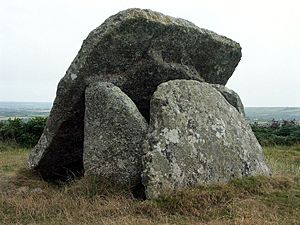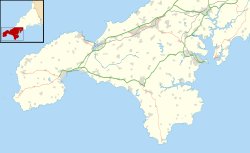Mulfra Quoit facts for kids
 |
|
| Location | Cornwall |
|---|---|
| Coordinates | 50°09′48″N 5°34′11″W / 50.16327°N 5.56977°W |
| Type | Dolmen |
| History | |
| Periods | Neolithic |
Mulfra Quoit is an ancient stone structure found in Cornwall, England. It's a type of monument called a dolmen, which is a tomb or chamber made from large stones. People from the Neolithic period, also known as the New Stone Age, built it. This was a time long ago when people first started farming.
You can find Mulfra Quoit standing on Mulfra Hill. This hill is just north of a small village called Mulfra.
Where is Mulfra Quoit Located?
Mulfra Quoit is in the western part of Penzance. It sits between the areas of Porthmeor and New Mill. Being on top of Mulfra Hill, it offers amazing views. You can even see the sea from there, looking over the nearby hills.
What Does Mulfra Quoit Look Like?
Mulfra Quoit is quite similar to another ancient structure called Chûn Quoit. Chûn Quoit is only about five kilometers away. Mulfra Quoit has three large stones that stand upright. These stones are about 1.7 meters (5.5 feet) tall.
They are arranged in a U-shape, which is about 3.0 meters (9.8 feet) long and 1.7 meters (5.5 feet) wide. One side of the U-shape is open. A huge, flat stone, called a capstone, rests on top of these support stones.
The capstone has slipped down over time. It measures about 3.2 meters by 3.0 meters (10.5 by 9.8 feet). This almost square stone is very heavy, weighing around 5 tonnes! That's like the weight of a large elephant.
Some of the original stones that formed the chamber are now missing. This makes it hard to know exactly how it looked when it was first built. It's possible that four pillars once held up the capstone, just like at Chûn Quoit.
However, the capstone has a bump on its underside in the middle. This bump might have helped it sit steadily on the three stones we see today. It seems Mulfra Quoit was once covered by a large mound of earth. You can still see small parts of this mound around the stones.
Who Studied Mulfra Quoit?
Many years ago, people became interested in ancient sites like Mulfra Quoit. In 1769, a historian named William Borlase drew a picture and a plan of the quoit. He wrote that there was a low stone wall, about 60 centimeters (2 feet) high, that circled the dolmen. This wall was about 12 meters (39 feet) across. Today, you can't see any sign of this wall.
Borlase also mentioned another stone that he thought was part of the capstone. This stone is also gone now. He noted that the ground around the quoit was covered with about 30 centimeters (1 foot) of soil. He believed this soil was left over from the original mound that covered the structure.
Later, in 1872, William Borlase's relative, William Copeland Borlase, also studied the site. He looked at a pile of stones in the middle of the dolmen. He even dug into the ground there. All he found was some burnt wood.
There was a local story that Mulfra Quoit had been damaged by lightning in 1752. However, W. C. Borlase said this wasn't true. His ancestor, William Borlase, had seen the quoit in 1749. At that time, it looked pretty much the same as it does today. This means the lightning story was probably just a myth.
Because Mulfra Quoit is not as complete as some other ancient sites, later researchers didn't pay it as much attention. In 1932, a person named Hencken compared it to Chûn Quoit. He simply called it "a very similar but less perfect chamber."
In 1950, Glyn Daniel also mentioned Mulfra Quoit. He called it a "typical rectangular" chamber and provided a drawing of its shape.



